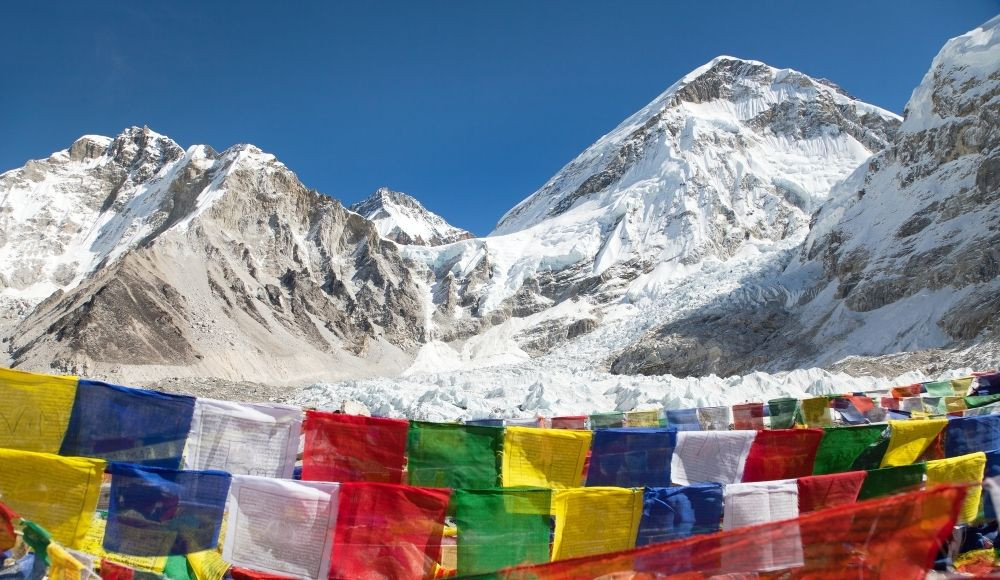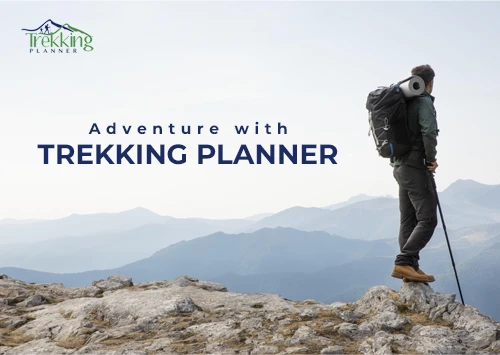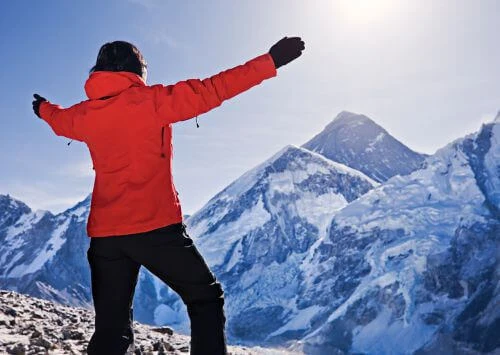Why Choose September, October, and November for Trekking in Nepal?
Nepal's autumn, from September to November, is considered one of the best times to embark on a Trekking Adventure in this beautiful country. The weather during these months is mild and stable, with clear skies and moderate temperatures that make trekking comfortable and enjoyable. The monsoon season ends in August, leaving the landscapes refreshed and vibrant, with lush greenery and blooming flowers.
This is also when the crowds thin out, allowing trekkers to enjoy a more tranquil and immersive experience. The stunning autumn scenery and favorable weather conditions make it an ideal time to explore Nepal's majestic mountains and valleys.
Weather Conditions During Autumn (September, October, and November )in Nepal.
During autumn, Nepal experiences stable weather conditions that are favorable for trekking. The daytime temperatures in the lower regions range from 20 to 25 degrees Celsius, while the nights can be cooler, especially at higher altitudes. Clear skies, with minimal rainfall and low humidity, provide excellent visibility of the surrounding mountains and landscapes.
However, it's important to note that the weather in the mountains can be unpredictable, and trekkers should be prepared for sudden changes in temperature and occasional rainfall. It is advisable to dress in layers and carry proper gear to ensure comfort and safety throughout the trek.
Why is Autumn the Best Time of the Year for Trekking in Nepal?
Nepal’s trekking trails offer everything—from scorching sunrays to freezing cold nights, crowded trekking trails to ghost towns, and incessant monsoon rain to sweet summer breezes. There are so many different trekking trails in Nepal that you will have plenty of options throughout the year. Although autumn is Nepal's best trekking season after spring, it has the highest footprints.
In this blog, we will further explain why trekking in autumn is the best time to explore Nepal's stunning landscapes.
The weather is perfect.
Autumn in Nepal lasts from mid-September to November. It starts right after the end of the monsoon season in the hills. Thus, the days are neither too hot nor too cold. Everything in sight turns a bright orange color. And with no clouds in sight, the days become livelier and more vibrant. The trekking trails are neither too wet nor slippery, making it easier to trek.
Moreover, the weather and climate of Nepal are neither too scorching nor too freezing. Thus, the weather in autumn is just perfect for trekking. However, the days are a bit shorter than spring days, meaning you will have less daylight.
For more detailed information about trekking this season, check out our guide to trekking in Nepal from September to November.
Witnessing Nepalese festivals.
Many of Nepal’s significant festivals fall during autumn. In Nepal, an agricultural country, autumn is the time for merrymaking as people finish all of the farm work during the monsoon. Dashain and Tihar, the most significant festivals of Nepalese Hindus, also fall during autumn. Similarly, ancient Buddhist festivals of the mountainous region, like Mani Rimdu and Saga Dawa, also fall during autumn.
These festivals are characterized by ritualistic dances, lavish pujas, ancient ceremonies, and much traveling. Moreover, people are in the happiest moods, lifting the aura of the vicinity by several folds. These festivals enrich your trekking journey and lead to an unforgettable experience. Moreover, you experience these festivals firsthand and gain a new perspective on the religious and cultural elements of Hinduism and Buddhism in Nepal.
Popular Trekking Routes in Nepal During Autumn.
Nepal offers a wide range of trekking routes that showcase its diverse landscapes and breathtaking beauty. Some of the most popular treks in autumn include the Everest Base Camp, Annapurna Circuit, and LangtangValley. The Everest Base Camp trek takes you through the heart of the Khumbu region, offering spectacular views of Mt. Everest, Lhotse, and Nuptse. The Annapurna Circuit Trekking is known for its dramatic mountain scenery, diverse flora and fauna, and cultural encounters with the local communities. The Langtang Valley trek combines stunning mountain vistas with opportunities to explore the unique Tamang and Sherpa cultures. These treks, among others, provide a perfect blend of natural beauty, adventure, and cultural immersion.

The choice is endless.
Autumn is an ideal time for the Everest Gokyo Valley Trek, offering a range of trekking options without restrictions on destinations. Unlike winter and monsoon treks, autumn allows you to explore high-altitude treks above 5,500 meters or venture to remote snowbound areas in winter. Tea houses and services in popular and lesser-traveled regions remain open during this peak season.
For example, you can trek to Kanchenjunga Base Camp, which requires an organized trekking group, or explore the Dolpa region, which becomes inaccessible in winter.
Excellent visibility in the mountains.
Autumn comes right after the ongoing monsoon. It means that the large, ominous clouds start exhausting and dissipating, paving the way for bright blue skies. Typically, in the mountains, clouds roll over quickly to obscure the view of the Himalayas. It means you can only have perfect glimpses of mountains for a very short time, early morning. However, with clouds vanishing under the autumn sky, the visibility is excellent and at its maximum. You can view the mountains from very far, even before you reach halfway through the trekking trail.
Also, once you get to a higher elevation, you don’t have to worry much about the mountains disappearing under large fluffs of clouds. You can relish in the Himalayan view as much as you want and translate these beauties into stunning photographs.
Interacting with fellow trekkers.
During autumn, the main trekking trails of the mountainous region are packed with trekkers from all across the world. While this news may not seem pleasant for someone looking for solitude and seclusion during a trek, for others, it is an excellent opportunity to interact and mingle with like-minded mountain lovers. You can chat around and discuss over a cup of tea with fellow trekkers who might be going to either the same destination or a different one, the ever-hardworking Sherpas, and the warm and hospitable lodge owners. You will never know what you’ll learn.
Tips for Preparing for a Trek in Nepal's Autumn Season.
Before going on a trek in Nepal's autumn season, it's essential to be well-prepared to ensure a safe and enjoyable experience. Firstly, ensure proper trekking gear, including sturdy hiking boots, a waterproof jacket, warm clothing, and a good-quality backpack. It's also advisable to carry a first aid kit, water purification tablets, and a high-quality sleeping bag suitable for the expected temperatures. For detailed equipment, read our blog "Suggested Equipment List."
Physical fitness is crucial for trekking, so it's recommended that you engage in regular exercise and build stamina before the trek. Additionally, familiarize yourself with the trekking route, its difficulty level, and the necessary permits and paperwork. Lastly, don't forget to pack essentials such as sunscreen, sunglasses, a hat, and a camera to capture the incredible moments along the way.
Accommodation Options and Facilities During Autumn Treks in Nepal.
During autumn treks in Nepal, various accommodation options are available to suit different preferences and budgets. Teahouses, also known as guesthouses, are famous among trekkers as they provide basic amenities such as a bed, meals, and hot showers. These teahouses are scattered along the trekking routes and offer a chance to interact with fellow trekkers and experience local hospitality.
For those seeking a more luxurious experience, upscale lodges and hotels are also available in certain trekking regions. However, the level of facilities may vary depending on the remoteness of the trekking route. It's advisable to book accommodation in advance, especially during peak trekking seasons, to ensure availability.
Safety Precautions and Considerations During Autumn Treks in Nepal.
Safety should always be a top priority when trekking in Nepal, regardless of the season. Knowing the risks associated with high altitudes, such as altitude sickness, is essential during autumn treks. It's recommended that the body acclimatize properly by gradually ascending and taking rest days to allow the body to adjust to the changing altitude.
Hydration is crucial, so drink plenty of water and avoid alcohol and caffeine. It's also advisable to trek with a licensed guide who is experienced in the region and can provide guidance and support throughout the journey. Additionally, ensure that you have adequate travel insurance that covers trekking activities and emergency evacuations if needed.

Cultural Experiences and Festivals During Autumn in Nepal.
Autumn in Nepal is not only a season of natural beauty but also a time of vibrant cultural celebrations. During this time, various festivals and religious ceremonies take place, adding an extra layer of cultural immersion to your trekking experience. One of the most significant festivals celebrated during autumn is Dashain, a Hindu festival that symbolizes the victory of good over evil.
The festival involves elaborate rituals, feasting, and the flying of kites, creating a festive atmosphere across the country. Another important festival is Tihar, also known as Diwali, which is a celebration of lights and is observed by both Hindus and Buddhists. These cultural experiences provide a unique opportunity to witness Nepal's rich traditions and interact with the local communities.
Recommended Trekking Itineraries for September, October, and November.
To make the most of your trekking adventure in Nepal's autumn season, here are some recommended itineraries that cover the popular trekking routes:
- Everest Base Camp Trek (11-21 days): This iconic trek takes you to the base camp of the world's highest mountain, Mount Everest. The journey starts with a scenic flight to Lukla and continues through the picturesque villages of Namche Bazaar, Tengboche, Dingboche, and Gorak Shep. Experience the thrill of standing at the base camp and enjoy panoramic views from Kala Patthar.
- Annapurna Circuit Trek (10-19 days): This classic trek offers a complete circuit around the Annapurna Massif, showcasing diverse landscapes, from lush valleys to high alpine passes. Starting from Besi Sahar, the trek passes through beautiful villages like Manang and Muktinath, before descending to the picturesque city of Pokhara.
- Langtang Valley Trek (8-18 days): Explore the enchanting Langtang Valley, located north of Kathmandu. This trek takes you through lush forests, serene valleys, and traditional Tamang villages. Enjoy panoramic views of snow-capped peaks and visit the sacred Kyanjin Gompa.
These are just a few examples of the many trekking itineraries available during Nepal's autumn season. The duration and difficulty level can be customized according to your preferences and fitness level.

Conclusion: Embrace the Beauty of Nepal's Autumn Through Trekking.
Nepal's autumn is a magical time to embark on a trekking adventure that will leave you with unforgettable memories. The vibrant colors, pleasant weather, and cultural festivities make it an ideal season to explore Nepal's stunning landscapes and immerse yourself in its rich heritage. With Trekking Planner Nepal, you can trust in our expertise and dedication to providing you with an exceptional trekking experience.
Whether you choose to trek to Everest Base Camp, Annapurna Circuit, Langtang Valley, or any other route, we will ensure that you have a safe, comfortable, and awe-inspiring journey. Unlock the beauty of Nepal's autumn and let the adventure begin!









